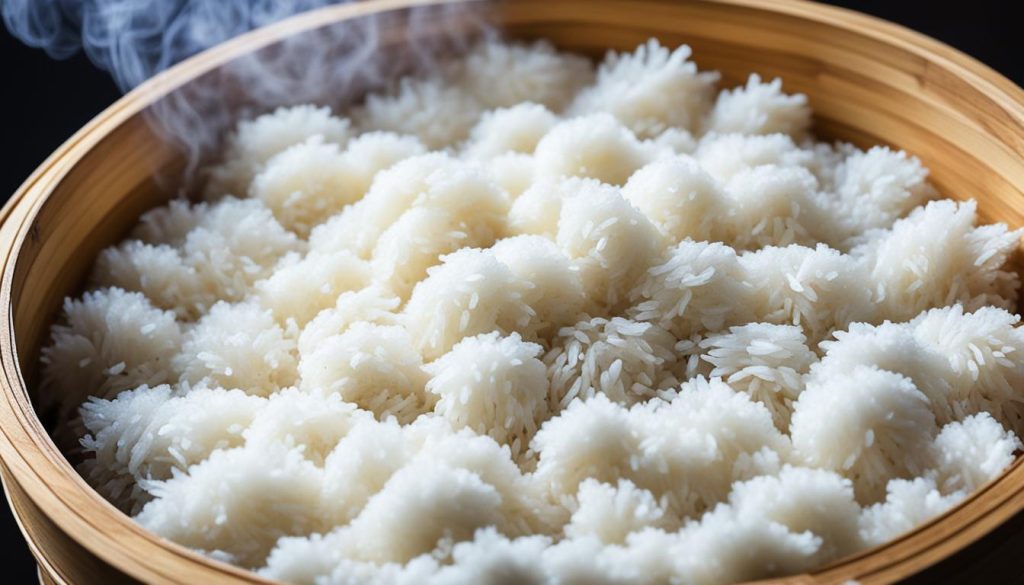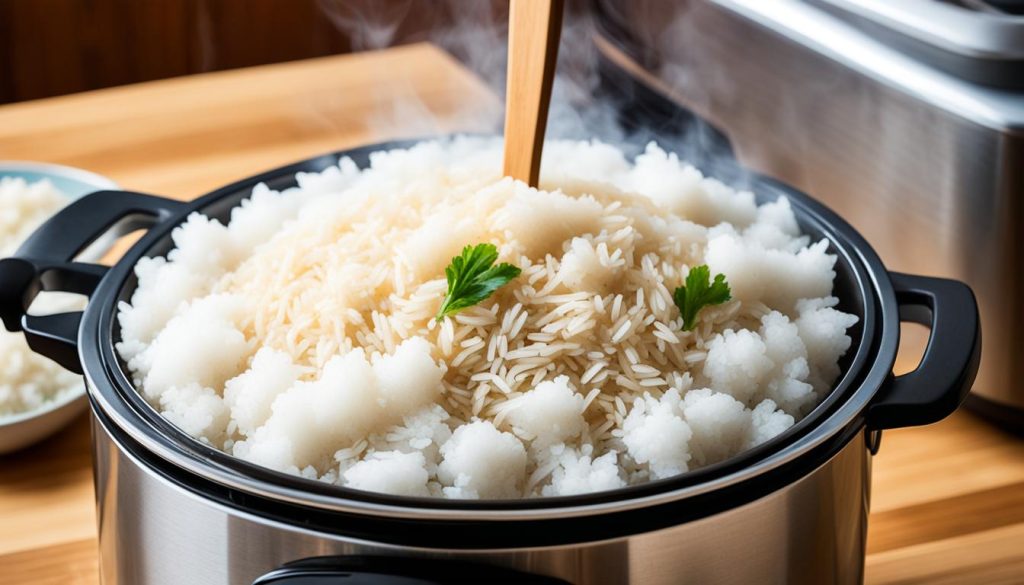Have you ever had that amazing, soft goodness of Asian sticky rice? It’s a must-have in dishes like Thai curries and mango sticky rice sweets. Making it at home might sound hard, but it’s not. With some tips, you can make this rice just like they do in restaurants.
Making sticky rice is different from cooking other rice types. You don’t just boil it in water. You need to soak and steam it to get that chewy, sticky texture. But don’t worry, I’ll share a few secrets to help you make perfect sticky rice at home.
What is Sticky Rice?
Sticky Rice vs Regular Rice
Different Names for Sticky Rice
Sticky rice is short-grain rice with a lot of amylopectin, making it stick when cooked. It’s key in Asian cooking, used in both sweets and meals. You might know it as glutinous rice, sweet rice, or Thai sticky rice. But it all means the same thing: a sticky, short-grain, starchy rice.
Key Takeaways
- Sticky rice, also known as glutinous rice or sweet rice, is a short-grain variety with a high amylopectin content that gives it a distinctive chewy, sticky texture when cooked.
- Sticky rice is commonly used in many Asian cuisines, especially in desserts and savory dishes, and goes by several names like glutinous rice, sweet rice, and Thai sticky rice.
- Cooking sticky rice requires a different method than regular long-grain rice, typically involving soaking and steaming rather than simmering in water.
- There are several techniques for making sticky rice at home, including the traditional cold soak method, the quicker hot soak method, and using a rice cooker.
- Mastering the art of cooking sticky rice takes some practice, but the results are well worth it – a delightfully sticky, chewy texture that elevates both sweet and savory dishes.
What is Sticky Rice?
Sticky rice, also known as glutinous rice, stands out because of how it sticks together when cooked. This is thanks to its high amylopectin content. This gives it a sticky, chewy texture. It’s key in many Asian cuisines for both sweet and savory dishes. Some popular dishes include mango sticky rice, sticky rice dumplings (zongzi), and sticky rice shumai.
Sticky Rice vs Regular Rice
The big difference between sticky rice and regular rice is their starch makeup. Sticky rice has more amylopectin. It’s what makes the rice sticky when cooked. On the other hand, regular long-grain rice has more amylose. This leads to a drier, less sticky outcome.
Different Names for Sticky Rice
Sticky rice has many names like glutinous rice, sweet rice, and Thai sticky rice. But they all point to the same kind of short-grain, high in starch rice. All these names show its vital role in lots of Asian dishes.
Traditional Cold Soak Method
Making sticky rice the traditional way starts with a cold soak. This simple process brings out the rice’s natural stickiness. It makes the rice perfectly chewy.
Soaking Time for Perfect Texture
The secret to great cold soak sticky rice is the length of time it soaks. Ideally, soak the rice for 3 hours at least. For an even softer, stickier rice, you can soak it as long as 6 to 24 hours.
This soaking time lets the grains absorb water fully. It makes the rice achieve its sticky, glutinous texture.
Steaming Implements for Sticky Rice
Once the rice is soaked, it’s ready to steam. You can use a bamboo steamer, a metal one, or a pot with a rack. Steaming keeps the rice from getting mushy or cooked too much.

How do you make sticky rice?
There’s a traditional cold soak method, but a quicker way is the hot soak method. For sticky rice, rinse it and pour boiling water over it. Let it soak about 20 minutes. This method makes the rice soft and sticky faster.
Hot Soak Method
Start the hot soak method by rinsing your sticky rice. This gets rid of extra starch. Then, boil water in a pot. Pour the water over the rice so it’s covered by about 1 inch. Let it soak for 20 minutes. Adjust time for different rice amounts. Lastly, rinse the rice with cold water to remove leftover starch.
Tips for Hot Soak Sticky Rice
Here are helpful tips for making perfect hot soak sticky rice:
- Use just enough water to cover the rice by about 1 inch
- Adjust the soaking time based on the amount of rice – less time for larger batches
- Rinse the rice with cool water after soaking to remove excess starch
Adjusting for Desired Texture
The hot soak method lets you adjust how sticky your rice gets easily. For firmer rice, soak for a shorter time, like 15-18 minutes. For a softer, stickier rice, go for 20-25 minutes. Play with the soak time to reach your ideal sticky rice texture.
Rice Cooker Method for Sticky Rice
To cook sticky rice in a rice cooker easily, go for the rice cooker method. It cuts out the usual steps, like soaking, for making sticky rice in a rice cooker without soaking. Pour the rice and water into a 1:1.5 ratio, add some salt, and turn on the cooker. You don’t need a special setting for sticky rice. The regular mode is enough to get perfect, sticky results.
Tips for Rice Cooker Sticky Rice
Rinsing the rice can help to get just the right stickiness. And, when it’s done, let the rice sit in the cooker for a bit. This makes the grains absorb more water, becoming even stickier.

Conclusion
Sticky rice is a key part of many Asian meals, adding its unique taste to both main courses and desserts. The traditional cold soak way of making it is great, but there are quicker methods like hot soak and rice cookers. No matter how you cook it, the goal is to get that perfect sticky and chewy texture. With some practice, you can cook sticky rice like a pro at home.
Learning how to cook sticky rice opens a door to cooking many amazing dishes. You can make yummy desserts like Thai mango sticky rice or hearty meals found in Laos. Once you know the best ways to cook sticky rice, your cooking skills will really stand out. Your loved ones will be impressed with the great meals you’ll create.
Don’t worry if cooking sticky rice seems hard at first. With the right steps and a bit of patience, you’ll get it right every time. Take on the challenge of cooking sticky rice and show off your cooking talents with tasty Asian dishes.


